Cardiff City F.C.
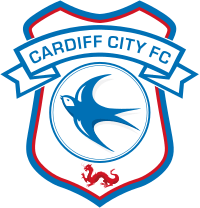 | ||||
| Full name | Cardiff City Football Club | |||
|---|---|---|---|---|
| Nickname(s) | The Bluebirds | |||
| Short name | CAR, CCFC, City | |||
| Founded | 1899 (as Riverside A.F.C.) | |||
| Ground | Cardiff City Stadium | |||
| Capacity | 33,280 | |||
| Owner | Vincent Tan | |||
| Chairman | Mehmet Dalman | |||
| Manager | Neil Warnock | |||
| League | Premier League | |||
| 2017–18 | Championship, 2nd of 24 (promoted) | |||
| Website | Club website | |||
|
| ||||
Cardiff City Football Club (Welsh: Clwb Pêl-droed Dinas Caerdydd) is a professional association football club based in the city of Cardiff, Wales, that competes in the Premier League, the top tier of the English football league system.
Founded in 1899 as Riverside A.F.C., the club changed its name to Cardiff City in 1908 and joined the English football league system in 1910, competing in the Southern Football League before joining the Football League in 1920. They are the only club from outside England to have won the FA Cup, doing so in 1927. They have also reached three other cup finals in English competitions, the 1925 FA Cup Final against Sheffield United, the 2008 FA Cup Final against Portsmouth and the 2012 Football League Cup Final against Liverpool, suffering defeat on each occasion, and have won the Welsh Cup on 22 occasions, making them the second most successful team in the competition's history behind Wrexham. The team's longest period in the top-tier of English football came between 1921 and 1929 and they have spent nine seasons in the top-flight since this period, the most recent being in 2018–19.
Since 1908, the club's home colours have been blue and white, leading to a nickname of The Bluebirds, with the exception of a period between 2012 and 2015 when the club's owner, Vincent Tan, rebranded the club and changed the home colours to red. They reverted to their traditional blue in January 2015.[1] Cardiff play their home games at the Cardiff City Stadium, after moving from Ninian Park in 2009, and have long-standing rivalries with nearby clubs Swansea City, known as the South Wales derby, and Bristol City, known as the Severnside derby.
History
Early years (1899–1920)
The club was founded in 1899 as Riverside A.F.C.,[2] following a meeting at the home of Bartley Wilson in Cardiff,[3] as a way of keeping players from the Riverside Cricket Club together and in shape during the winter months.[4] Their first season saw them playing friendlies against local sides at their Sophia Gardens ground, but in 1900 they joined the Cardiff & District League for their first competitive season. In 1905, Cardiff was granted city status by King Edward VII, and as a result the club put in a request to the South Wales and Monmouthshire Football Association to change their name to Cardiff City,[2] but the request was turned down as they were deemed to be not playing at a high enough level. To combat this they arranged to join the South Wales Amateur League in 1907 and the following year they were granted permission to change the name of the club to Cardiff City.[5][6]
With the club growing in stature, they were forced to turn down the opportunity to join the newly formed Second Division of the Southern Football League due to the lack of facilities at their Sophia Gardens ground. Over the next two years, Cardiff played friendlies against some of Britain's top professional sides, including Middlesbrough, Bristol City and Crystal Palace, with the matches being played at various grounds in Cardiff and nearby towns. The club eventually secured land to build their own stadium, moving into Ninian Park in 1910, and made its first signing the following year with the acquisition of Jack Evans from fellow Welsh side Cwmparc.[6]
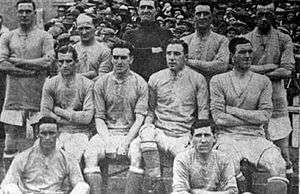
With the new ground in place, Cardiff joined the Southern Football League Second Division,[7] and appointed their first manager in Davy McDougall, who became player-manager.[8] They went on to finish in fourth place in their first year in the league but the board decided to replace McDougall with Fred Stewart, who had previous managerial experience with Stockport County.[3] Stewart set about adopting a more professional approach, signing several players with Football League experience, including brothers John and George Burton and Billy Hardy, and led the team to promotion in his second season, winning the Second Division title. They remained in the First Division for the next decade, finishing in the top four on two occasions, although the league was suspended due to the outbreak of World War I between 1915 and 1919.[6][9]
1920s success and later decline (1920–1945)
In 1920, the club submitted a successful application to join the Football League and were placed into the Second Division for the 1920–21 season.[6] Stewart brought in several players with Football League experience, breaking the club's transfer record on two occasions to sign Jimmy Gill and later Jimmy Blair from The Wednesday. They played their first match in the Football League on 28 August 1920, defeating Stockport County 5–2,[10] and finished the season in second place to win promotion to the First Division,[7] finishing behind Birmingham City on goal average, and also reached the semi-final of the FA Cup.[11] In their third season in the top-tier, the team finished runners-up to Huddersfield Town due to a goal average difference of 0.024,[7][11][12] drawing their final match 0–0 as club record goalscorer Len Davies missed a penalty.[11]
The following season was the first time Cardiff City appeared at Wembley Stadium, reaching their first ever FA Cup final,[7] losing 1–0 to Sheffield United following a goal from England international Fred Tunstall.[11] Although the 1926–27 season was Cardiff's worst performance in the top tier of English Football since they had won promotion six seasons prior, finishing in 14th position, they reached their second FA Cup final in the space of two years.[11] On St George's Day, 23 April 1927, at Wembley Stadium in London, Cardiff became the only non-English side to win the FA Cup by defeating Arsenal 1–0 in the final,[13] Hughie Ferguson scoring the only goal of the game. In the 74th minute, he received the ball from Ernie Curtis and hurried a tame shot toward the Arsenal goal.[14] Dan Lewis, the Arsenal goalkeeper, appeared to collect the ball but, under pressure from the advancing Len Davies, clumsily allowed the ball to roll through his grasp. In a further attempt to retrieve the ball Lewis only succeeded in knocking the ball with his elbow into his own net.[15] Captain Fred Keenor received the FA Cup trophy at the end of the match from King George V only seven years after Cardiff City had entered the Football League.[11]
The side also won the Welsh Cup in 1927 defeating Rhyl 2–0 and would go on to win the FA Charity Shield after beating amateur side the Corinthians 2–1 at Stamford Bridge.[16][11][17] However, the club soon entered a decline after their cup success and were relegated from the First Division in the 1928–29 season, despite conceding fewer goals than any other side in the division,[18] and suffered a second relegation two years later, dropping into the Third Division South for the first time since they joined the Football League.[7] During their time in the division, Cardiff recorded their biggest ever win when they beat Thames by a scoreline of 9–2 but,[19] after finishing the 1932–33 season in 19th place, manager Fred Stewart tendered his resignation from his post after 22 years in charge of the team.[11] Club founder Bartley Wilson stepped in to replace Stewart; however the results continued to be disappointing, and in March 1934, Ben Watts-Jones was given the opportunity to manage the club he had supported as a youngster. However, he was unable to turn the team's fortunes around by the end of the season, meaning Cardiff City were forced to apply for re-election after finishing bottom of the division.[3] Watts-Jones remained in charge for another three years until he was replaced by Bill Jennings but Cardiff remained in the Third Division South until the Football League was suspended following the outbreak of World War II.[7][11]
Post war and European competition (1945–2000)
In their first season since the return of the Football League, Cardiff finished the 1946–47 season as champions of the Third Division South under new manager Billy McCandless and returned to the Second Division.[20] McCandless left the club soon after and was replaced by Cyril Spiers who led the side to promotion in the 1951–52 season,[7][21] returning to the top tier of English football for the first time in 23 years.[11] However, despite spending five seasons in the First Division, the team continually struggled in the bottom half of the table and were eventually relegated in 1957.[21] They returned to the First Division for two seasons between 1960 and 1962 before again suffering relegation.[7]
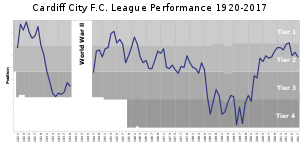
During the 1960s, Cardiff began qualifying for European competition for the first time as a result of winning the Welsh Cup. Their first ever match in European competition was in the European Cup Winners Cup during the 1964–65 season against Danish side Esbjerg fB, winning 1–0 on aggregate over two legs, the only goal being scored by Peter King.[22] They went on to reach the quarter-finals before being knocked out by Real Zaragoza.[7] Despite their exploits in Europe, the team were still struggling in league competition under the stewardship of Jimmy Scoular, finishing in 20th position in the Second Division.[23] Two years later the team would go on to reach the semi-final of the Cup Winners Cup, the furthest any Welsh side has advanced in European competition,[24] after victories over Shamrock Rovers, NAC Breda, and Torpedo Moscow set up a tie with German side Hamburg,[7] whose squad contained a number of German internationals. After a 1–1 draw in the first leg, just over 43,000 fans turned out at Ninian Park to watch Hamburg win 3–2.[23][25] During the 1970–71 season, Cardiff reached the quarter-finals of the Cup Winners Cup where they faced Spanish side Real Madrid. The first leg of the tie was held at Ninian Park where 47,000 fans watched one of the most famous victories in Cardiff's history when Brian Clark headed in to give Cardiff a 1–0 win,[5][26] although they were later eliminated after losing the second leg 2–0.[23] The team remained in the Second Division for 19 of the 20 seasons between 1962 and 1982, being relegated to the Third Division for one season during the 1975–76 season.[7][27]
After dropping into the Third Division, Cardiff were continuously in the lower two divisions of the Football League between 1985 and 1993 as the club appointed several managers in attempts to stabilize the team's performances.[27] They were relegated to the Fourth Division once in the 1985–86 season and, despite returning to the Third Division on two occasions, in 1996 finished in their lowest-ever league position – 22nd of 24 in Division Three.[28] In 1995, Cardiff and other Welsh clubs competing in English leagues were banned from entering the Welsh Cup by the Football Association of Wales after pressure from UEFA,[29] who did not want teams playing in two national cup competitions.[30] Their final match in the competition was a 2–1 defeat to Wrexham in the 1995 final.[7]
Foreign investment (2000–present)
In August 2000, Lebanese businessman Sam Hammam purchased control of the club.[31] Shortly after taking over, Hammam controversially pledged to get the entire Welsh nation to support Cardiff by renaming the club "The Cardiff Celts" and changing the club colours to green, red and white.[32] However, after lengthy talks with senior players and fans, he decided that the best policy was not to change the name of the club; however the club crest was redesigned. This new design incorporated the Cardiff City bluebird in front of the Flag of Saint David; and featured the club's nickname superimposed at the top of the crest.[33] Hammam invested heavily in the team, funding the transfers of several new players that saw Lennie Lawrence guide Cardiff to promotion via a Second Division play-off triumph in 2003 against Queens Park Rangers,[34] substitute Andy Campbell came off the bench to score the only goal in extra time and ensure Cardiff returned to Division One after an 18-year absence.[31]
The Bluebirds established themselves in Division One but, after failing to get the new stadium plans agreed by Cardiff Council due to concerns over financial security in 2006,[31] Hammam agreed to a takeover by a consortium led by new chairman Peter Ridsdale and the lead developer of the new stadium, Paul Guy. During the takeover, Hamamm was accused of "total greed and self-interest" by the club's board and they revealed spiraling costs had left the club crippled by debt.[35] During the 2007–08 season, Cardiff reached the semi-final of the FA Cup for the first time in 81 years after beating Middlesbrough 2–0 on 9 March 2008.[31] After coming through their semi-final against Barnsley with a 1–0 win at Wembley Stadium on 6 April with a goal from Joe Ledley,[36] they eventually lost 1–0 to Portsmouth in the final.[31]
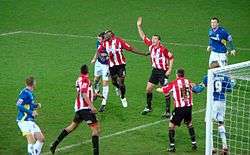
In May 2010, Malaysian Datuk Chan Tien Ghee took over as club chairman, with Vincent Tan also investing and joining the board.[37] The following year, the club appointed Malky Mackay as manager,[38] who took the side to the League Cup final for the first time in the club's history during his first season.[7] The following season, Cardiff won the 2012–13 Championship title and with it gained promotion to the Premier League for the first time, returning to the first-tier for the first time in 52 years.[39][40] On 18 August 2013, Cardiff played their first ever Premier League match away to West Ham United, losing 2–0.[41] Cardiff won only three games in the first half of the season and, on 27 December 2013, Mackay was sacked by Vincent Tan following showdown talks and replaced by Ole Gunnar Solskjær.[42][43] Despite the change, Cardiff were relegated to the Championship after a single season following a 3–0 away defeat to Newcastle United.[44] Solskjær himself was sacked on 18 September 2014 after a disappointing start to the following Championship season, and replaced by Leyton Orient manager Russell Slade.[45]
In October 2016, Neil Warnock was appointed first team manager of Cardiff.[46] Warnock took over the team with Cardiff second bottom of the table after two wins from 11 games, however, Cardiff finished the 2016–17 season 12th after a good run of form.[47] The start of the 2017–18 season saw Cardiff break a club record of winning their opening three league games of a season, the first time in the club's 107-year professional history.[48] They proceeded to clinch promotion to the Premier League after finishing second in the table.
Rivalry
.jpg)
Cardiff City's most significant rivalry is with nearby neighbours Swansea City, known as the South Wales derby, with the two sides having played each other over 100 times in all competitions. Swansea's first ever competitive fixture following their founding in 1912 was against Cardiff in the Southern Football League.[4] In April 2006, relations between Cardiff City supporters and Swansea City supporters were aggravated after Swansea won the Football League Trophy final against Carlisle United at the Millennium Stadium in Cardiff. During their celebrations, Swansea players Lee Trundle and Alan Tate brandished a Welsh flag with an anti-Cardiff obscenity written on it in. As well as carrying the flag, Trundle was also seen wearing a T-shirt with an image of a Swansea City player urinating on a Cardiff City shirt.[49] The Football Association of Wales (FAW) said the images paraded at the match, which took place at Cardiff's Millennium Stadium on 2 April 2006, were "of an extremely offensive and insulting nature and such behaviour is totally unacceptable". The two players in question were arrested by the Police on suspicion of section four public order offences, fined £2,000, and handed one-match suspensions.[50]
Further afield, the club has a rivalry with Bristol City, known as the Severnside derby, and to a lesser extent, Bristol Rovers. There is also a lesser rivalry with Welsh neighbours Newport County due to the proximity of the two Welsh cities. However, they have rarely played against each other since the 1980s due to Cardiff being in higher leagues. In total they have only ever played 20 Football League games against each other. A survey by Football Fans Census in 2003 saw Swansea, Bristol City and Newport listed as Cardiff's main three rivalries, with Stoke City matching Newport in third.[51]
Rivalries with other clubs, as well as their fans' frustration at Cardiff's struggles in the 1980s, saw the emergence of a hooligan group within the club's fanbase that became known as the Soul Crew.[52] The group became notorious for their violent clashes with rival supporters and have seen brawls between sets of supporters at football matches and other events.[53][54]
Stadia
Ninian Park
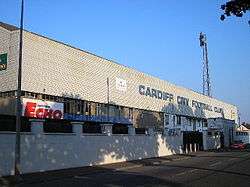
Cardiff's first ground was at Sophia Gardens recreational park where they played from their founding in 1899 until 1910 when,[55] due to the lack of facilities at the ground and the increasing amount of support for the club, Bartley Wilson contacted Bute Estate, who owned large amounts of Cardiff at the time, in an attempt to find land suitable for building a stadium. They eventually agreed on an area of waste ground on Sloper Road. The land was a former rubbish tip and required extensive work to get a playable surface, but with the assistance of Cardiff Corporation and volunteers the work was completed. The ground was originally to be known as Sloper Park but was instead named after Lord Ninian Crichton-Stuart, who was a large force in helping the club get the ground built, and became Ninian Park.[56] The ground hosted its first match on 1 September 1910 with a friendly against Aston Villa,[5] with the kick-off being performed by Lord Crichton-Stuart.[57]
The stadium was built with one stand before the opening of another in 1928 which could hold 18,000 people to replace an earth embankment. It hosted its first international match in March 1911 with a Welsh match against Scotland.[57] Towards the end of its lifespan, the ground eventually was replaced by Cardiff Arms Park as increasing doubts mounted over the safety of the aging ground.[58] The club record attendance in the ground is 57,893 which was achieved during a league match against Arsenal on 22 April 1953.[59] The record stands to this day, and is unlikely to be beaten due to the scaling down of grounds throughout the 1970s and 1980s due to safety fears, which saw the ground capacity fall to 22,000. In its final years of its use, the club was forced to seek special dispensation from authorities in order to keep the remaining standing areas of the ground open as clubs at Championship level or above were given three years to redevelop their grounds to remove standing areas.[60][61]
Cardiff City Stadium
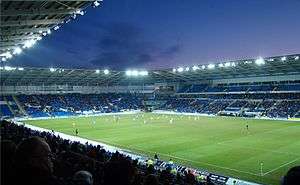
In June 2009, the club completed construction of a state-of-the-art 26,828 seater stadium on the site of the now-demolished old Cardiff Athletics Stadium at a cost of £48 million.[62][63] The project required the rebuilding of the athletics stadium, to be known as Cardiff International Sports Stadium, on the opposite side of Leckwith Road in Cardiff.[64]
On 20 September 2007 it was announced that the Cardiff Blues rugby union club would leave their Cardiff Arms Park home to become tenants of Cardiff City at the new Leckwith stadium,[65] a move which caused controversy among the rugby club's fans.[66] The ground was eventually named the "Cardiff City Stadium" and three of the four stands would keep the names used at Ninian Park, the Grange End, the Canton Stand and the Grandstand and the fourth stand would be called the Ninian Stand.[62] The naming rights of the ground were expected to be sold, with the club hoping to generate up to £9 million of income with the rights, however they remain unsold.[62] Although a pre-season friendly against Chasetown was played at the ground with limited capacity to test safety features,[67] the stadium was officially opened with a friendly against Scottish side Celtic on 22 July 2009.[68] The first competitive match to be played at the ground saw Cardiff record a 4–0 victory over Scunthorpe United on 8 August 2009, the opening day of the 2009–10 season.[69]
In August 2014, expansion plans were completed, increasing the stadium capacity to 33,316. However, in March 2015, it was announced that the Ninian Stand extension was to be shut for the 2015–16 season due to poor ticket sales, dropping the capacity to 27,978.[70]
Colours, kit and crest
Colours
When Riverside A.F.C. was formed in 1899, the club used a chocolate-brown and amber checkered shirt.[2] Following the club's name change to Cardiff City 1908, they adopted a blue shirt and white or blue shorts and socks, although for the first nine years black socks were used. Kit changes over the club's history have included all blue kits, the introduction of a yellow vertical stripe during the 1970s and alternating blue stripes.[33]
In 2012, Cardiff controversially changed their home kit colours from the traditional blue, white and yellow to red and black,[71] the first time the club had not worn blue as its primary colour since 1910. The crest was also changed to one in which the Welsh Dragon was more prominent than the traditional bluebird. The crest was changed to "appeal in 'international markets'" and was part of a "major investment plan" unveiled by chairman Vincent Tan.[72] The change angered fans, who expressed their opposition in news and social media as well as directly to management and a number of protest marches and demonstrations were held to voice displeasure at the change.[73][74] Despite Tan previously stating that the club would only return to wearing blue if another owner was found, on 9 January 2015, after three seasons playing in the red kit, the club reverted their home kit back to blue with a red away kit in a bid to "unite" the club.[75][76]
Original strip used as Riverside A.F.C. before 1908 |
Cardiff's original colours from 1908 |
Cardiff's lighter blue strip used between 1926 and 1930. |
All blue kits were used in 1992–1996 and 2000–2007 |
The 2009–10 strip with yellow being re-added |
Cardiff's primary colours were changed from blue to red between 2012 and 2015. |
Cardiff reverted to their traditional blue halfway through the 2014–15 season. |
Crest history
From 1908 Cardiff played in unadorned shirts. This changed in 1959, when they played in shirts with a simple crest featuring an image of a bluebird. The following season their shirts were featureless, and remained so until 1965, when they played in shirts with the word "Bluebirds" embroidered. A new crest, similar to the one previously used and again featuring a bluebird, was introduced in 1969. Variations on this crest remained until the 1980s, when extra features including words and additional motifs were added. A major change was made in 2012, when owner Vincent Tan attempted to rebrand the club in order to expand the club's appeal outside Wales.[77] This change gave large prominence to the Welsh Dragon, reducing the bluebird to a minor feature. In March 2015, Cardiff announced a new crest which would predominantly feature the Bluebird once again with an oriental dragon replacing the standard Welsh dragon.[78]
Kit manufacturers and shirt sponsors
| Period | Kit manufacturer[33] | Shirt sponsor[33] |
|---|---|---|
| 1973–82 | Umbro | None |
| 1983 | Whitbread Wales | |
| 1984 | Superted
Camilleri Roofing | |
| 1984–85 | Merthyr Motor Auctions | |
| 1985–87 | Admiral | Airways Cymru |
| 1987–88 | Buckley's Brewery | |
| 1988–89 | Scoreline | |
| 1989–90 | Havelet | |
| 1990–91 | None | |
| 1991–92 | Influence | |
| 1992–94 | Bluebirds | South Wales Echo |
| 1994–95 | Strika | |
| 1995–96 | Influence | |
| 1996–97 | Lotto | |
| 1997–98 | Errea | Gilesports |
| 1998–99 | Xara | Sports Cafe |
| 1999–2000 | Modplan | |
| 2000–02 | Ken Thorne Group | |
| 2002–03 | Puma | Leekes |
| 2003–05 | Redrow Homes | |
| 2005–06 | Joma | |
| 2006–08 | Communications Direct | |
| 2008–09 | Vansdirect | |
| 2009–10 | 777.com | |
| 2010–11 | Puma | SBOBET |
| 2011–14 | Malaysia tourist board and BBC Cymru | |
| 2014–15 | Cosway Sports | |
| 2015– | Adidas |
Players
First-team squad
- As of 28 August 2018[79]
Note: Flags indicate national team as defined under FIFA eligibility rules. Players may hold more than one non-FIFA nationality.
|
|
Out on loan
Note: Flags indicate national team as defined under FIFA eligibility rules. Players may hold more than one non-FIFA nationality.
|
|
Academy
Cardiff currently runs a youth academy, with a number of youth groups from ages seven to eighteen years.[80] Recent players to come through the youth system include Wales internationals Joe Ledley, Chris Gunter, Aaron Ramsey, Adam Matthews, Darcy Blake and Declan John and,[81] prior to the youth system being granted academy status, Robert Earnshaw and James Collins.
Notable former players
Backroom staff
| Position[82] | Name |
|---|---|
| Manager | Neil Warnock |
| Assistant Manager | Kevin Blackwell |
| First Team Coach | Ronnie Jepson |
| Coach | James Rowberry |
| Goalkeeper Coach | Andy Dibble |
| Head of Fitness & Conditioning | Carl Serrant & Lee Southernwood |
| Head of Medical | Paul Godfrey |
| First Team Physiotherapist | Edward Richmond |
| Senior Strength & Conditioning | Mike Beere |
| Club Doctor | Dr. Len Nokes |
| Player Development Manager | Craig Bellamy |
| Chief Scout | Glyn Chamberlain |
Manager history
|
|
Records

The record for the most appearances in all competitions is currently held by Billy Hardy who appeared in 590 matches for the club between 1911 and 1932, including in the Southern Football League.[84] Phil Dwyer has made the most appearances in the Football League era, having played in 575 matches. Len Davies is the club's top goalscorer with 179 goals in all competitions. Seven other players, Peter King, Robert Earnshaw, Brian Clark, Carl Dale, Derek Tapscott, Jimmy Gill and John Toshack have also scored 100 or more goals for the club.[85]
Jack Evans became the first Cardiff City player to win an international cap on 13 April 1912 when he represented Wales in a 3–2 defeat to Ireland. The player who has won the most caps as a Cardiff player is Alf Sherwood who won 39 caps for Wales during his spell with the club.[86] The highest transfer fee that the club has paid for a player is £9.5 million for Gary Medel in 2013 from Spanish side Sevilla.[87] A year later, Medel became the most expensive player sold by the club when he joined Inter Milan for £10 million.[88]
Cardiff's largest victory was a 16–0 victory over Knighton Town in the fifth round of the Welsh Cup in 1962. Their biggest league victory was a 9–2 victory over Thames on 6 February 1932 and their biggest FA Cup victory was an 8–0 victory over Enfield on 28 November 1931.[89]
Honours
Cardiff City's honours include the following:[90]
Second Division/First Division/Championship (As second tier)
Third Division (South)/Third Division/Second Division/League One (As third tier)
Fourth Division/Third Division/League Two (As fourth tier)
- Winners: – 1927
- Finalists: – 2012
Southern Football League Second Division
- Champions: – 1912–13[91]
- Winners: – 1912, 1920, 1922, 1923, 1927, 1928, 1930, 1956, 1959, 1964, 1965, 1967, 1968, 1969, 1970, 1971, 1973, 1974, 1976, 1988, 1992, 1993
- Finalists: – 1929, 1939, 1951, 1960, 1994, 1995
- Winners: – 2002
- Finalists: – 1998, 2000
Sources
References
- ↑ "Statement from Tan Sri Vincent Tan". Cardiff City F.C. 9 January 2015. Retrieved 17 May 2015.
- 1 2 3 Steve Tucker (9 May 2012). "The obscure story of Cardiff City's blue kit and nickname". WalesOnline. Retrieved 21 August 2017.
- 1 2 3 Hayes 2006, p. 208
- 1 2 Hayes 2003, p. 5
- 1 2 3 Shepherd 2002, p. 4
- 1 2 3 4 Richard Shepherd (19 March 2013). "1899–1920 Foundations & the Early Years". Cardiff City F.C. Retrieved 22 January 2017.
- 1 2 3 4 5 6 7 8 9 10 11 12 13 "Cardiff City". Football Club History Database. Retrieved 22 January 2017.
- ↑ "Playing Manager Appointed". Evening Express. 14 September 1910. p. 4.
- ↑ Shepherd 2002, pp. 14–21
- ↑ "Opening Day History – Starting with success". Cardiff City F.C. 1 August 2017. Retrieved 9 September 2017.
- 1 2 3 4 5 6 7 8 9 10 Richard Shepherd (19 March 2013). "1920–1947 Great Days, Lows & Recovery". Cardiff City F.C. Retrieved 22 January 2017.
- ↑ McLean, Kirk. "Queens Legends: George McLachlan and the 1936 Overseas tour". Queen of the South F.C. Archived from the original on 26 February 2009. Retrieved 14 April 2009.
- ↑ Peter Shuttleworth (4 January 2009). "Cup friends reunited". BBC Sport. Retrieved 1 September 2017.
- ↑ Hayes 2006, p. 63
- ↑ The 1927 FA Cup (Television news production). BBC. 23 April 1927. Archived from the original (WMV) on 26 April 2006. Retrieved 14 April 2009.
- ↑ Shepherd 2002, p. 28
- ↑ Shepherd 2002, p. 29
- ↑ "Final Table for season 1928–29". English Football League Tables. Retrieved 22 January 2017.
- ↑ Shepherd 2002, p. 3
- ↑ Hayes 2006, p. 209
- 1 2 Richard Shepherd (20 March 2013). "1947–1964 Post-War Recovery". Cardiff City F.C. Retrieved 22 January 2017.
- ↑ Shepherd 2002, p. 64
- 1 2 3 Richard Shepherd (21 March 2013). "1964–1973 the Scoular Years". Cardiff City F.C. Retrieved 22 January 2017.
- ↑ "Welsh clubs in Europe". Welsh Football Data Archive. Retrieved 9 September 2017.
- ↑ Shepherd 2002, p. 67
- ↑ Peter Shuttleworth. "1971 – Cardiff City 1–0 Real Madrid". BBC Sport. Retrieved 9 September 2017.
- 1 2 Richard Shepherd (21 March 2013). "Friday Fame & 80s Pain". Cardiff City F.C. Retrieved 22 January 2017.
- ↑ Richard Shepherd (21 March 2013). "1989–1999 From Darkness into Light?". Cardiff City F.C. Retrieved 22 January 2017.
- ↑ "FAW seeks route into Europe for Cardiff and Swansea". BBC Sport. 13 March 2012. Retrieved 9 September 2017.
- ↑ "Cardiff City tempted by Welsh Cup return". BBC Sport. 21 April 2011. Retrieved 9 September 2017.
- 1 2 3 4 5 Richard Shepherd (21 March 2013). "2000–2010 Ignition & Progression". Cardiff City F.C. Retrieved 12 August 2017.
- ↑ Grahame Lloyd (8 August 2000). "Hammam dreams of Wales United". The Guardian. Retrieved 12 August 2017.
- 1 2 3 4 5 6 7 "Cardiff City". Historical Football Kits. Dave Moor. Retrieved 19 September 2017.
- ↑ David Conn (5 March 2005). "David Conn: Cardiff brought to their knees as financial reality bites for Hammam". The Independent. Retrieved 12 August 2017.
- ↑ "Hammam accused of Cardiff 'greed'". BBC Sport. 23 December 2006. Retrieved 3 January 2010.
- ↑ McKenzie, Andrew (6 April 2008). "Barnsley 0–1 Cardiff City (FA Cup Semi-final)". BBC Sport. Retrieved 3 January 2010.
- ↑ "Cardiff City chairman Dato Chan Tien Ghee resigns". BBC Sport. 1 March 2013. Retrieved 9 September 2017.
- ↑ "Malky Mackay is new City manager". Cardiff City F.C. 17 June 2011. Archived from the original on 6 April 2012. Retrieved 13 September 2013.
- ↑ "Premier League promotion party starts at Cardiff City after 0–0 draw against Charlton Athletic". The Daily Telegraph. 16 April 2013. Retrieved 17 April 2013.
- ↑ "Cardiff City 0–0 Charlton Athletic". BBC Sport. 16 April 2013. Retrieved 17 April 2013.
- ↑ "West Ham United 2–0 Cardiff City". BBC Sport. 18 August 2013. Retrieved 19 August 2013.
- ↑ "Malky Mackay: Cardiff City sack manager". BBC Sport. 27 December 2013. Retrieved 8 April 2015.
- ↑ "Ole Gunnar Solskjaer: Cardiff City hire former Man Utd striker as boss". BBC Sport. 2 January 2014. Retrieved 8 April 2015.
- ↑ "Newcastle 3–0 Cardiff". BBC Sport. 3 May 2014. Retrieved 8 April 2015.
- ↑ "Cardiff City: Russell Slade confirmed as new manager". BBC Sport. 6 October 2014. Retrieved 6 October 2014.
- ↑ "Neil Warnock Appointed as New City Manager". Cardiff City F.C. 5 October 2016. Retrieved 5 October 2016.
- ↑ "Huddersfield Town 0–3 Cardiff City". BBC Sport. 7 May 2017. Retrieved 7 May 2017.
- ↑ "Cardiff City 2–0 Sheffield United". BBC Sport. 15 August 2017. Retrieved 15 August 2017.
- ↑ "Swansea insults disappoint Hammam". BBC Sport. 3 April 2006. Retrieved 3 January 2010.
- ↑ "Swans pair arrested over insults". BBC Sport. 5 April 2006. Retrieved 3 January 2010.
- ↑ "Rivalry uncovered!" (PDF). Football Fans Census. Archived from the original (PDF) on 20 October 2013.
- ↑ "Confessions of a hooligan". South Wales Echo. 9 March 2002. Retrieved 31 August 2017.
- ↑ "How Soul Crew became notorious". South Wales Echo. 8 June 2008. Retrieved 31 August 2017.
- ↑ "Court told how rivalry between Cardiff City and Swansea City fans sparked mass brawl at racecourse". WalesOnline. 13 November 2013. Retrieved 31 August 2017.
- ↑ "From Sophia to SWALEC". cricketarchive.co.uk. Archived from the original on 9 November 2012. Retrieved 2 November 2008.
- ↑ "Fans bid farewell to Ninian Park". BBC News. 5 May 2009. Retrieved 12 August 2017.
- 1 2 Hayes 2003, p. 7
- ↑ Hayes 2003, p. 8
- ↑ "Bluebirds average attendances". Cardiff City F.C. 8 May 2008. Archived from the original on 14 February 2012. Retrieved 23 March 2010.
- ↑ Terry Phillips (11 July 2009). "Steve Borley wanted standing areas at Cardiff City Stadium". WalesOnline. Retrieved 9 September 2017.
- ↑ "Keep Scunthorpe Standing". The Football Supporters' Federation. 23 September 2010. Retrieved 9 September 2017.
- 1 2 3 "Bluebirds ground named 'The Cardiff City Stadium'". WalesOnline. 21 March 2009. Retrieved 12 August 2017.
- ↑ Simon Gaskell (17 June 2013). "Cardiff City unveil plans for 38,000-capacity stadium expansion". WalesOnline. Retrieved 9 September 2017.
- ↑ "The Leckwith Vision". Cardiff City F.C. 23 August 2017. Retrieved 9 September 2017.
- ↑ "Cardiff teams agree ground share". BBC Sport. 19 September 2007. Retrieved 3 January 2010.
- ↑ Jon Doel (8 May 2012). "Cardiff Blues return to Arms Park as Cardiff City consider rebranding". WalesOnline. Retrieved 9 September 2017.
- ↑ "Cardiff City 4–Chasetown". BBC Sport. 11 July 2009. Retrieved 12 August 2017.
- ↑ "Cardiff City 0–0 Celtic". BBC Sport. 22 July 2009. Retrieved 12 August 2017.
- ↑ "Cardiff City 4–0 Scunthorpe United". BBC Sport. 8 August 2009. Retrieved 12 August 2017.
- ↑ "Cardiff City's new £12m Ninian Stand to be mothballed less than a year after opening". WalesOnline. 31 March 2015. Retrieved 7 May 2015.
- ↑ "Cardiff City 2012/13 kits revealed". Cardiff City F.C. 6 June 2012. Archived from the original on 16 May 2013. Retrieved 10 September 2013.
- ↑ "Cardiff City to change kit from blue to red amid financial investment". BBC Sport. 6 June 2012.
- ↑ Simon Gaskell (8 June 2012). "Fans and designers criticise Cardiff City's new emblem". WalesOnline. Retrieved 12 August 2017.
- ↑ "Thousands of Cardiff City fans march against club's blue to red rebrand". BBC News. 22 March 2014. Retrieved 30 August 2017.
- ↑ "Cardiff City owner Vincent Tan agrees return to blue home kit". BBC Sport. Retrieved 9 January 2015.
- ↑ Stuart James (9 January 2015). "Cardiff revert to blue kit after Vincent Tan approves change". The Guardian. Retrieved 30 August 2017.
- ↑ "Cardiff City to change kit from blue to red amid financial investment". BBC Sport. 6 June 2012. Retrieved 9 January 2015.
- ↑ "Cardiff City 2015 crest reveal". Cardiff City F.C. 9 March 2015. Retrieved 9 March 2015.
- ↑ "Cardiff City FC Player Profiles". Cardiff City F.C.
- ↑ Nathan Blake (19 April 2017). "Cardiff City's academy must start producing if the Bluebirds want to compete with the Premier League big boys". WalesOnline. Retrieved 1 September 2017.
- ↑ "Dick Bate named new Cardiff Academy boss". BBC Sport. 2 November 2012. Retrieved 1 September 2017.
- ↑ "Management". Cardiff City F.C. Retrieved 9 September 2017.
- 1 2 3 4 "Cardiff City Manager History". Soccerbase.com. Retrieved 12 August 2017.
- ↑ Shepherd 2002, pp. 15–33
- ↑ Shepherd 2002, pp. 104–113
- ↑ Hayes 2006, pp. 218–219
- ↑ Jon Doel (10 July 2013). "Cardiff City's record signings". WalesOnline. Retrieved 12 June 2018.
- ↑ "Inter Milan: Cardiff City's Gary Medel joins club for £10m". BBC Sport. Retrieved 27 August 2014.
- ↑ "Club records". Cardiff City F.C. Retrieved 12 August 2017.
- ↑ "Cardiff City football club honours". 11vs11.com. Retrieved 12 August 2017.
- ↑ Shepherd 2002, p. 16
Bibliography
- Shepherd, Richard (2007). The Cardiff City Miscellany. Sussex: Pitch Publishing. ISBN 1-905411-04-9.
- Shepherd, Richard (2002), The Definitive: Cardiff City F.C., Nottingham: SoccerData Publications, ISBN 1-899468-17-X
- Hayes, Dean P. (2003). The South Wales Derbies. Manchester: The Parrs Wood Press. ISBN 1-903158-43-5.
- Hayes, Dean (2006), The Who's Who of Cardiff City, Nottingham: Breedon Books, ISBN 1-85983-462-0
External links
| Wikimedia Commons has media related to Cardiff City F.C.. |
- Cardiff City F.C. Official website
- Cardiff City F.C. on BBC Sport: Club news – Recent results and fixtures
- A collection of items relating to Cardiff City Football Club's historic victory against Arsenal in the 1927 FA Cup
- Cardiff City stats at Football Club History Database
- Cardiff City play-off record
_logo.png)
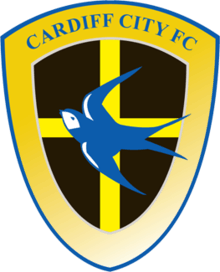

.svg.png)